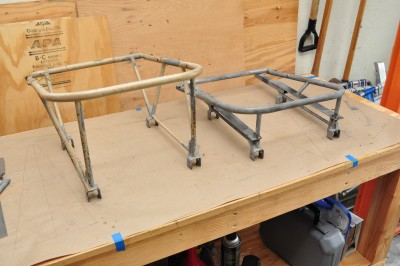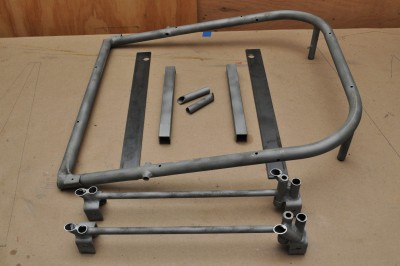Though I spent most of the week at AirVenture, I did have a little bit of time to work on the seat frame for my Bede BD-4C airplane. I am adapting seats from a Piper airplane and the first post is here, Individual BD-4C Seats. Today, I finished tack welding the first seat. Here are photos of that one, along side an unmodified seat frame. (You can click any photo to see a larger version.)


Here is a photo so you can see how the pieces fit together.

I started by cutting the front legs down 0.2 inches shorter than the tube for the locking mechanism for sliding the seat forward and backward. I cut the back legs 0.75 inches shorter than the front.
I welded a piece of 0.75 inch square tubing on top of the back legs. I welded a piece of steel bar on top of the cut-off legs at the front of the frame and on top of the square tubing at the back. Then I welded the top of the seat frame to the top of the steel bar and the square tubing. Finally, I added a small diagonal brace. (I did this twice, once for each side of the seat frame.)

Today ended with a trip to the EAA Chapter 32 building to use the big sandblasting cabinet to clean up the parts for the second seat. Here is the full set of what I have had to modify to make the Piper seats fit into the Bede BD-4C airplane.

The remainder of the seat frame (the seat back and the latching mechanism) are unchanged. I removed them so that I can strip the old paint. I will also replace all of the nuts, bolts, and washers with new hardware.

Young Jim Bede and I talked about you last week. We both think you’re doing very well on your BD-4C. Keep up the great work!
Interesting to see your project. Nice work! I have a question about the BD-4. How do you achieve the correct wing dihedral? It looks like the system of the large pipe spar carry through would result in a flat wing with no dihedral.
You’re right. The BD-4C wing is flat, with no dihedral.